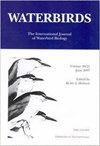估算种群筑巢水鸟数量的直接与间接调查方法比较
IF 0.6
4区 生物学
Q3 ORNITHOLOGY
引用次数: 1
摘要
摘要从监测工作中得出的人口估计数可能对所选择的调查方法很敏感,可能导致有偏见的估计和相对于真实人口规模的低精度。虽然小型无人机系统(UAS)提供了一个独特的机会来调查鸟类种群,同时限制干扰,相对而言,人们对这种方法与更传统的方法相比知之甚少。在这项研究中,我们比较了美国马里兰州切萨皮克湾(Chesapeake Bay)混合种群中雪白鹭(Egretta thula)和牛白鹭(Bubulcus ibis)的种群估计,这些估计来自于无人机照片计数、同花期计数、飞行路线调查和种群内巢穴计数,以及通过每种方法得出估计所需的时间。我们发现,与巢数和飞行路线调查相比,UAS计数和同花顺计数产生的配对估计值更低(P < 0.05),所需时间显著缩短(x′= 6、8、84和90分钟)。这些结果表明,尽管UAS有可能从难以到达或对其他方法固有干扰特别敏感的繁殖群体中收集有价值的调查数据,但在比较调查类型的结果时应考虑固有的偏差,并应谨慎使用。本文章由计算机程序翻译,如有差异,请以英文原文为准。
A Comparison of Direct & Indirect Survey Methods for Estimating Colonial Nesting Waterbird Populations
Abstract. Population estimates derived from monitoring efforts can be sensitive to the survey method selected, potentially leading to biased estimates and low precision relative to true population size. While small unmanned aerial systems (UAS) present a unique opportunity to survey avian populations while limiting disturbance, relatively little is known about how this method compares with more traditional approaches. In this study we compared population estimates of Snowy (Egretta thula) and Cattle Egrets (Bubulcus ibis) in a mixed-species colony in the Chesapeake Bay (Maryland, USA) derived from UAS photo counts, flush counts, flight-line surveys, and in-colony nest counts along with the time required to derive an estimate via each approach. We found that UAS counts and flush counts produced lower pair estimates than nest counts and flight-line surveys (P < 0.05), and required dramatically less time (x̄ = 6, 8, 84 and 90 min, respectively). These results suggest that while UAS have the potential to collect valuable survey data from breeding colonies that are hard to reach or are especially sensitive to the disturbance inherent in other methods, inherent biases should be considered and caution should be used when comparing results between survey types.
求助全文
通过发布文献求助,成功后即可免费获取论文全文。
去求助
来源期刊

Waterbirds
生物-鸟类学
CiteScore
1.30
自引率
0.00%
发文量
0
审稿时长
6-12 weeks
期刊介绍:
Waterbirds is an international scientific journal of the Waterbird Society. The journal is published four times a year (March, June, September and December) and specializes in the biology, abundance, ecology, management and conservation of all waterbird species living in marine, estuarine and freshwater habitats. Waterbirds welcomes submission of scientific articles and notes containing the results of original studies worldwide, unsolicited critical commentary and reviews of appropriate topics.
 求助内容:
求助内容: 应助结果提醒方式:
应助结果提醒方式:


